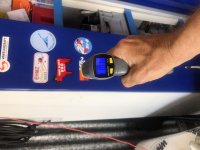Tankerpilot75
Well Known Member
I’m having trouble re-starting my engine after shutdown for refueling.
I’ve got a Superior IO-360 with dual PMags which are timed at 3 teeth (~ 6* ATDC). The PMag manual says:
a) MasterON.
b) Openthrottle1⁄4”
c) Mixture
(1) Cold Engine:
1. Mixturefullrich.
2. BoostpumpONuntilpressurerisesthenOFF.
. 3. Returnmixturetolean.
(2) Hot Engine:
1. Leavemixturelean.
2. Noboost.
d) Crankuntilfirstfire(typically3to4blades).
Following the Hot Engine procedure it just won’t start and if it initially tries, it runs rough then dies. The air temperatures were high (102 degrees) so I’m sure fuel vaporization inside a hot engine compartment is occurring.
A friend suggested leaving the mixture off, throttle full forward, boost pump on to get cooler fuel to the throttle body, boost pump off, throttle set to 1/2 then start. Feed in mixture once started.
Frankly this seems to me that I’d likely flood everything. But obviously the PMag manual procedure isn’t working.
I’ve got a Superior IO-360 with dual PMags which are timed at 3 teeth (~ 6* ATDC). The PMag manual says:
a) MasterON.
b) Openthrottle1⁄4”
c) Mixture
(1) Cold Engine:
1. Mixturefullrich.
2. BoostpumpONuntilpressurerisesthenOFF.
. 3. Returnmixturetolean.
(2) Hot Engine:
1. Leavemixturelean.
2. Noboost.
d) Crankuntilfirstfire(typically3to4blades).
Following the Hot Engine procedure it just won’t start and if it initially tries, it runs rough then dies. The air temperatures were high (102 degrees) so I’m sure fuel vaporization inside a hot engine compartment is occurring.
A friend suggested leaving the mixture off, throttle full forward, boost pump on to get cooler fuel to the throttle body, boost pump off, throttle set to 1/2 then start. Feed in mixture once started.
Frankly this seems to me that I’d likely flood everything. But obviously the PMag manual procedure isn’t working.





